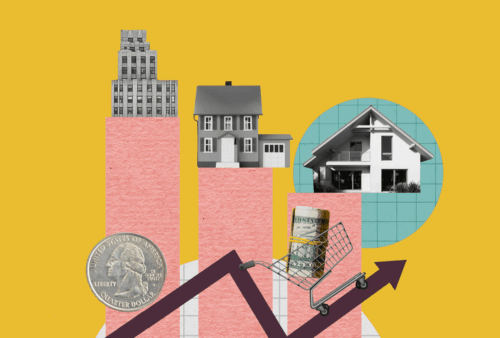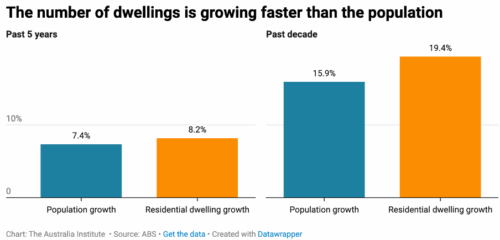

The Australian property market offers competitive returns at a minimal risk, but continuous investor demand has resulted in high barriers to entry within the sector. Young Aussies now stand in protest against the rising property prices that are becoming unaffordable when combined with the high cost of living and the tight labour market. Australia’s rapidly growing population requires adequate real estate construction. However, the country’s geographical landscape is prone to bushfires, storms, and government restrictions, compelling buyers to reside in overcrowded metropolitan cities. Timely intervention could secure housing for the next generation of Australia, but under current political complacency, could a home become a distant dream for Aussies?
The average home price in Australia’s capital cities was documented to have risen by 3,435% despite only a 1,183% increase in the median full-time wage. Homes worth $34,000 in 1975 now cost $1,627,625 in 2024. Buyers could easily finance homes in 1975, but today they face prices 9.5 times the median wage, which makes it difficult for even double-income households to purchase a home.
Following the first interest cut in 2025, the value of residential dwellings rose to $11.6 trillion in the June quarter, a $250 billion increase from March’s $11.35 trillion figure. Due to the tight market and lack of properties available in crowded cities such as Melbourne and Sydney, property prices in medium-sized Brisbane, Adelaide, and Perth grew 10% from 2023 to 2024, while Melbourne and Sydney experienced price increases of 2.1% and 3.66% respectively.
Leveraging the interest rate cut, investors jumped into the overheated market, and the number of new loan commitments issued rose by 3.5% over the June quarter (with a 1.4% value increase) while new occupier loans rose merely 0.9% with a sharper rise in value of 2.4%. 1.7% more loan commitments were made for first home buyers; however, they faced a steep rise in value of 5.7%. The change in value is a key lending indicator that spotlights the comparatively higher investor movement in the property market than first home buyers, who now need to borrow more to purchase a property in the competitive market. Investors are entering the property market three times faster than owner-occupiers, highlighting the high barriers to entry for Australian youth and young families seeking to join the real estate industry.

Figure 1: Number of new loan commitments for dwellings, seasonally adjusted for Australia

Figure 2: Value of new loan commitments for dwellings, seasonally adjusted for Australia
Source: Australian Bureau of Statistics
Market sentiment predicts accelerating property prices, making the Australian property market ideal for investors. However, the Australian dream of owning a home seems distant for first-home buyers.
Rising house prices arise from a combination of high demand and limited supply. On the demand side, low interest rates and easier access to credit make borrowing cheaper, while population growth and investor activity add pressure to the market. On the supply side, rising construction costs and limited new housing limit dwelling availability.
Low interest rates
The Reserve Bank of Australia recently announced a rate cut of 0.25%, causing the interest rate to fall from 3.85% to 3.60%. When interest rates fall, the cost of monthly loan repayments decreases, which boosts demand for properties, and hence, dwelling prices increase. Consequently, the recent rate cuts announced by the RBA have increased housing demand.

Source: Investopedia
Cheaper and accessible borrowing
In 2025, the average new loan size for owner-occupiers in Australia hit a record high of $666,000, compared to $366,000 10 years ago. Loans and mortgages are becoming accessible to buyers, and interest rate cuts prompt more Australians to purchase a property. Investors, in particular, seek to leverage the high borrowing power granted by low interest cuts to achieve competitive returns on their investment.
Population Growth & Immigration
Media debate has recently sparked over the issue of immigration in Australia, which has affected sectors like the housing market and potentially contributed to the rising cost of living. Protests and rallies occurred at the weekends of September 2025, led by anti-immigration activists who argue that mass migration created competition in the housing market. The activists blame increased foreign investment and the large number of immigrants choosing to settle in Australia.
However, economists argue that “migrants are not to blame for soaring house prices”. Compared against the Australian population, the number of residential dwellings has increased by 8.2% within the past decade, while population growth was 7.4%. During the COVID-19 pandemic, almost 100,000 migrants left Australia. However, housing prices still rose 20% within the 18 months from March 2020 to September 2021.

Figure 3. Population Growth versus Residential dwelling growth
Source: Australian Bureau of Statistics
If immigrants were the sole driver of rising house prices, the average dwelling should have reduced in value during COVID rather than increasing in value by 20%.
Australian Taxation Policies for Properties
In 1999, a 50% capital gains tax discount was offered alongside negative gearing, prompting investors to rush into the property market to redeem the 50% tax-free profit when prices rose.
Moreover, investors can claim interest charged through mortgages on a property as a tax deduction, which posits as an attractive investment strategy for investors with an income in the top tax bracket, who are required to pay 47% of their income in the form of tax.
Implementation of policies favourable for first-home buyers will make the property market more accessible for young Australians seeking to purchase their first home.
Location and Demographic Constraints
Australian land is prone to bushfires, floods, and earthquakes, which sometimes make regional suburbs difficult to invest in. Living in regional suburbs offers affordable dwellings but comes at the cost of a few transport options and long travel times, especially for people headed towards the CBD. Hence, property purchasers tend to prefer housing options in metropolitan areas, resulting in overcrowding and a lack of property supply in these locations, which raises housing prices.
Government intervention can be a key factor in manipulating property prices and can help ease them, or may inflate prices for different stakeholder groups.
The Australian Labour Party (Labour) has committed $10 billion to build 100,000 homes over 8 years, which will be exclusively available to first-home buyers for purchase. Tax incentives will be provided to property developers seeking to construct properties and rent them in the market.
Conversely, the Coalition seeks to implement measures such as tax deduction on mortgage interest payments, a housing infrastructure fund and access to superannuation for housing. The Coalition also aims to reduce net migration by 100,000 people, including cutting international student levels.
Both parties advocate that income limits under the First Home Buyers Guarantee should be abolished, allowing any first home buyer to purchase with a 5% deposit and no Lenders Mortgage insurance, which on average costs buyers $23000. Also, they agree that foreign investors will be banned from the Australian housing market for 2 years.

Source: ABC News
Economists argue that government schemes may create a false sense of financial security for buyers, considering that the RBA is likely to announce more interest rate cuts, which will drive up property prices. While most of these schemes are under debate and scrutiny, they seek to become active from 1st January 2026. The Home Guarantee Scheme is set to start from 1st October 2025.
In essence, purchasing a home in Australia is a difficult feat due to pressures from interest rate cuts, overcrowding, and various other constraints. The current high housing prices and government restrictions pose a challenge for foreign and local investors, tipping the scales in favour of first-home buyers. Purchasing property in Australia proves to be a valuable investment, and strong government support for first-home buyers will assist the next generation of Australians in acquiring a property. Securing a home in Australia is difficult, but also achievable.
ABC News (Australia). (2025, April 12). Election 2025: Labor’s five per cent deposits for first home buyers. ABC. https://www.abc.net.au/news/2025-04-12/election-2025-labor-five-per-cent-deposits-first-homebuyers/105169984
ABC News (Australia). (2025, April 16). What will housing promises do to the market? ABC. https://www.abc.net.au/news/2025-04-16/what-will-housing-promises-do-to-the-market/105179262
ABC News (Australia). (2025, May 26). Rate cuts: House prices, inflation, economy. ABC. https://www.abc.net.au/news/2025-05-26/rate-cuts-house-prices-inflation-economy/105333726
ABC News (Australia). (2025, September 15). Liberals mass immigration debate protests. ABC. https://www.abc.net.au/news/2025-09-15/liberals-mass-immigration-debate-protests/105771786
API Magazine. (2025, April 22). Are government grants pushing up property prices? API Magazine. https://www.apimagazine.com.au/news/article/are-government-grants-pushing-up-property-prices
Australian Bureau of Statistics. (2025). Lending indicators: Latest release. ABS. https://www.abs.gov.au/statistics/economy/finance/lending-indicators/latest-release
BBC News. (2025, April 11). Australian house prices: Why are they so high? BBC. https://www.bbc.com/news/articles/cq5wlevy647o
Home Loan Experts. (2025). 10 factors affecting the property market. Home Loan Experts. https://www.homeloanexperts.com.au/home-loan-articles/10-factors-affecting-the-property-market
Housing Australia. (2025, October 1). Unlimited places, higher property price caps for first home buyers. Housing Australia. https://www.housingaustralia.gov.au/media/unlimited-places-higher-property-price-caps-first-home-buyers-1-october-2025
Metropole Property Strategists. (2025, September 10). Melbourne housing market update. Metropole. https://metropole.com.au/melbourne-housing-market-update/
News.com.au. (2025, April 7). Proof it’s never been tougher to buy a home in Australia. News.com.au. https://www.news.com.au/finance/economy/interest-rates/proof-its-never-been-tougher-to-buy-a-home-in-australia/news-story/8c514f10d6d0b6d6e79b53ad5bf328d8
Real Estate Business. (2025, March 10). 50 years of data shows stark change in income-to-house price ratio. Real Estate Business. https://www.realestatebusiness.com.au/industry/29004-50-years-of-data-shows-stark-change-in-income-to-house-price-ratio
Realestate.com.au. (2025, February 15). Recordbreaking surge pushes Australian housing market value to $11.6 trillion. Realestate.com.au. https://www.realestate.com.au/news/recordbreaking-surge-pushes-australian-housing-market-value-to-116-trillion/
Realestate.com.au. (2025, September 1). How the latest interest rate cut will shape the spring housing market. Realestate.com.au. https://www.realestate.com.au/insights/how-the-latest-interest-rate-cut-will-shape-the-spring-housing-market/
Realestate.com.au. (2025, September 15). Warnings $500 billion could be wiped from property values by 2030. realestate.com.au. https://www.realestate.com.au/news/warnings-500-billion-could-be-wiped-from-property-values-by-2030/
Realestate.com.au. (n.d.). Victoria median house prices, property market data & suburb profiles. realestate.com.au. https://www.realestate.com.au/vic/
Reserve Bank of Australia. (2025). Factors behind the recent rise in house prices: Submission to the Productivity Commission. RBA. https://www.rba.gov.au/publications/submissions/housing-and-housing-finance/inquiry-productivity-commission-on-first-home/factors-behind-recent-rise-in-house-prices.html
SBS News. (2025, July 3). Australia’s new home loan records — and how much we’re borrowing. SBS. https://www.sbs.com.au/news/article/australias-new-home-loan-records-and-how-much-were-borrowing/4u8n68k9s
Smart Property Investment. (2025, March 19). Investor revival reshapes property market as owner-occupier growth stalls. Smart Property Investment. https://www.smartpropertyinvestment.com.au/investor-strategy/26673-investor-revival-reshapes-property-market-as-owner-occupier-growth-stalls
Taylor, D. (2025, August 5). Australia’s housing market would crash if these factors aligned. ABC News (Australia). https://www.abc.net.au/news/2025-08-05/unemployment-rate-property-market/105611230
The Australia Institute. (2025, June 20). Migrants are not to blame for soaring house prices. The Australia Institute. https://australiainstitute.org.au/post/migrants-are-not-to-blame-for-soaring-house-prices/
Yahoo Finance Australia. (2025, May 1). Australian suburbs where property prices rose up to $562,000 in three months after RBA catalyst. Yahoo Finance. https://au.finance.yahoo.com/news/australian-suburbs-where-property-prices-rose-up-to-562000-in-three-months-after-rba-catalyst-053540396.html
Yardney, M. (2025, September 15). This week’s Australian property market update – Latest data, state by state September 16th 2025. Property Update. https://propertyupdate.com.au/australian-property-market/
The CAINZ Digest is published by CAINZ, a student society affiliated with the Faculty of Business at the University of Melbourne. Opinions published are not necessarily those of the publishers, printers or editors. CAINZ and the University of Melbourne do not accept any responsibility for the accuracy of information contained in the publication.